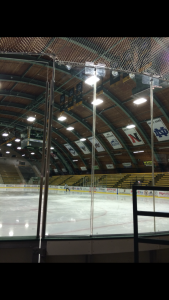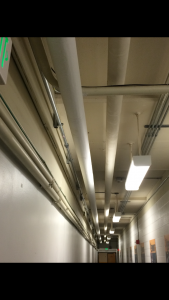R. Murray Schafer, the author of the article “The Soundscape”, advocates for the importance of sound appreciation around the world. Certainly, the world is an ever-changing place, so we have to pay attention to these changes to better understand the sounds around us. Our group finds UVM to have an extremely unique soundscape unlike any that we have ever experienced. UVM has an excessive amount of keynote sounds, or notes that identify the key or tonality of a particular composition. Keynote sounds do not have to be listened to consciously; they are overheard but cannot be overlooked, for keynote sounds become listening habits in spite of themselves. (Schafer 100). The wind, birds, insects, traffic noises and urban sounds are always overheard in our conscious audio field but never overlooked. Signals we hear around campus (foreground sounds that are listened to consciously) like the voices, phrases, and songs we hear daily, are all so unique to this school and cannot be experienced anywhere else. All of our experiences working in the Patrick Gymnasium and listening to its soundscape proves the importance of sound in a unique soundscape setting unlike any that we have ever experienced. All three members of our group were overwhelmed by the diversity and quantity of sounds being produced inside the Patrick Gym. Each section of the gym, whether it was the ice rink, weight room, or swimming pool, has a unique soundscape differing from one another while all being inside the same building.
During Noah’s soundwalk, he experienced an abundance of sounds being produced from the gym that were each unique to the area of the gym he was in. Starting off near the recreational studio and working his way towards the main lobby, the sounds of soft steps, metal lockers shutting, the removal of clothing, and the opening of doors to the main lobby all flooded the echoey cement hallway. During this sound walk, Noah found it interesting that the sounds were difficult to hear if his body was not still. He found that if he was trying to listen and walk at the same time, the acoustics of his body became keynote sounds and would almost always overpower the soundscape in his surrounding vicinity. Although his personal movements overpowered the surrounding sounds, this was not the case for when he sat and observed an ice hockey practice. The crashes and claps of the puck in the rink synchronizing with the skates gliding roughly on ice overpowered every sound in the area and overpowered his own movements proving that different sections of the gymnasium have different impacts on the level of sound being produced.
It is difficult to say which sounds are important to the gymnasium’s soundscape due to the fact that each section of the gym holds unique sounds important to that specific area. If you had to generalize the entire gym, the attribute to describe the collection of sounds produced from the Gym would fall under the category of an echo. The cement construction of the building allows sound, no matter what form of audio being produced, to travel and echo throughout. While the auditory action of the echo sounds seemed to dominate the gymnasiums soundscape, another keynote sound in the gym would have to be the mechanical sounds including but not limited to the pipes, vents, and electrical work running along the perimeter as well as the interior of the building. The constant buzzing/ hums throughout the gym’s interior are similar to the human heartbeat: always present, but not always felt/ heard. The sounds of different sports being played simply layer themselves over the most fundamental of sounds in the gymnasium: the mechanics. They identify the key parts of the gym and are extremely difficult to duplicate, thereby proving it to be a keynote sound.
Verbal sounds produced by people on this site, rather than machinery or actions, may offer a different perspective to the gym’s aural identity and offer encouragement and the continuation of those sounds. During Charlotte’s field observation in the pool, she noticed that the splash of the water and movement in the pool coupled with encouragement from other teammates amplified as each team member began to swim faster. Charlotte noticed a strong, positive correlation between verbal encouragement and physical performance. In essence, the swimmers swam quicker when the room was louder. The soundscape, amplified with the sounds of motion and movement, proves that certain sounds affect the interactions at the site. Matt noticed this as well when analyzing his field observation in the tennis court but in the opposite manor. While the players became increasingly more focused on the game, their vocal and aggressive manor diminished with each serve, and the sounds in the court decreased with the levels of concentration increasing. Both Matt and Charlotte expressed that the volume (whether that be loud or quiet) filled the room and became the dominant sound, experiencing sonic dominance in different ways throughout the Patrick Gym. The observation involving sonic dominance our group experienced can relate to Lawrence English’s statement interpreting sonic dominance as, “[a guide] to generate a specific particular sense of place rather than a general abstract idea of space. It’s as if the sound itself becomes both a source and expression of this power. (459)” This statement, provided by English, explains Matt and Charlotte’s observation in the gym, proving that certain verbal sounds on this site encourage either audio growth or decay and sonically dominate the surrounding vicinity.
All three members of our group have gained a newfound appreciation for the aural identity of the University of Vermont soundscape, especially the soundscape enclosed inside the Patrick Gymnasium. Each member of our group was able to experience something new and compelling, intriguing each of us to want to continue listening to the unique aural identity of the gym. We all found it so fascinating how there are so many levels to the gyms aural identity, and surpassed our expectations of the amount of sounds and acoustic motion that is present in the gym. While each member of our group experienced something different inside the gym, whether that be the sonic dominance of different sounds or even the sonic dominance of silence, we all were able to agree that the gym took on an aural identity of its own, sometimes producing certain compositions over which we have no control or showing that we are composers and responsible for its identity. So, “The final question will be: is the soundscape of the world an indeterminate composition over which we have no control, or are we its composers and performers, responsible for giving it form and beauty?” (96 Schafer)
UVM Soundscape Project: Patrick Gymnasium
Leave a reply


